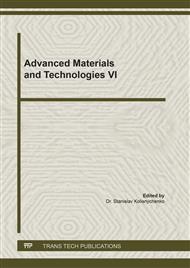[1]
M.S.S. Vijayakumar, B.V. Ramnath, Investigation on Mechanical and Thermal Properties of Stainless Steel Wire Mesh-Glass Fibre Reinforced Polymer Composite, silicon, (2018) vol. no. 10, p.2643–2651. doi.org/10.1007/s12633-018-9801-8.
DOI: 10.1007/s12633-018-9801-8
Google Scholar
[2]
V.B. Kurapati, Statistical Analysis and Mathematical Modeling of Dry Sliding Wear Parameters of 2024 Aluminium Hybrid Composites Reinforced with Fly Ash and SiC Particles, Trans. Indian Inst. Met. (2018), vol. no. 71, p.1809–1825.
DOI: 10.1007/s12666-018-1322-z
Google Scholar
[3]
E. Agrawal, V. Tungikar, Study on tribological properties of Al-TiC composites by Taguchi method, Mater. Today Proc. (2020) vol. no. 26, p.2242–2247.
DOI: 10.1016/j.matpr.2020.02.486
Google Scholar
[4]
V.K. Tripathi, S. Ambekar, Optimization and Analysis of Wear Rate of CFRP-NanoZno/Nanoclay Hybrid Composites Using RSM, J. Bio-Tribo-Corrosion. (2019), vol. no. 5, pp.1-13.
DOI: 10.1007/s40735-019-0284-y
Google Scholar
[5]
Karle A.H., Nukulwar M.R., Tungikar V.B.,(2020), Evaluation of mechanical and thermal properties of epoxy composites reinforced with CaSiO3 particulate fillers, Materials Today: Proceedings, doi.org/10.1016/j.matpr.2020.08.188.
DOI: 10.1016/j.matpr.2020.08.188
Google Scholar
[6]
G.R. Chavhan, L.N. Wankhade, Improvement of the mechanical properties of hybrid composites prepared by fibers, fiber-metals, and nano-filler particles – A review, Mater. Today Proc. (2020) vol. no. 27, p.2772–82.
DOI: 10.1016/j.matpr.2019.08.240
Google Scholar
[7]
R. Velmurugan, R.R.R, C. Dinesh, S. Balaji, Experimental Test of Stainless Steel Wire Mesh and Aluminium Alloy With Glass Fiber Reinforcement Hybrid Composite, (2015) vol. no. p.580–88.
Google Scholar
[8]
G.R. Chavhan, L.N. Wankhade, Experimental analysis of E-glass fiber/epoxy composite-material leaf spring used in automotive, Mater. Today Proc., (2020) vol. no. 26, p.373–377,.
DOI: 10.1016/j.matpr.2019.12.058
Google Scholar
[9]
A.A. Khan, E.H. Mirza, B.A. Mohamed, N.H. Alharthi, H.S. Abdo, R. Javed, R.S. Alhur, P.K. Vallittu, Physical , mechanical , chemical and thermal properties of nanoscale graphene oxide-poly methylmethacrylate composites, Journal of composite material, (2018).
DOI: 10.1177/0021998318754642
Google Scholar
[10]
B.D. Agarwal, L.J. Broutman, K. Chandrashekhara, Analysis and Performance of Fiber Composites, 2006.
Google Scholar
[11]
K. Friedrich, A.A. Almajid, L. Chang, Modern Polymer Composites for Friction and Wear Applications, Полімерний журнал. (2012), 34, No. 2, pp.108-119.
Google Scholar
[12]
J.K. Lancaster, The effect of carbon fibre reinforcement on the friction and wear of polymers, J. Phys. D. Appl. Phys. (1968) vol. no. 1, p.549–559.
DOI: 10.1088/0022-3727/1/5/303
Google Scholar
[13]
X. Cui, H. Zhang, S. Wang, L. Zhang, J. Ko, Design of lightweight multi-material automotive bodies using new material performance indices of thin-walled beams for the material selection with crashworthiness consideration, Mater. Des. (2011) vol. no. 32, p.815–821.
DOI: 10.1016/j.matdes.2010.07.018
Google Scholar
[14]
C.Ã. Soutis, Fibre reinforced composites in aircraft construction, Prog. Aerosp. Sci. 41 (2005) 143–151.
Google Scholar
[15]
J. Bijwe, R. Rattan, M. Fahim, S. Tiwari, Polyvinyl Alcohol-Modified Pithecellobium Clypearia Benth Herbal Residue FiberPolypropylene Composites, Polym. Compos. (2016) vol. no. 37, p.915–924.
DOI: 10.1002/pc.23250
Google Scholar
[16]
C. Wu, Y. Gao, J. Fang, E. Lund, Q. Li, Discrete topology optimization of ply orientation for a carbon fiber reinforced plastic (CFRP) laminate vehicle door, Mater. Des. (2017) vol. no. 128, p.9–19.
DOI: 10.1016/j.matdes.2017.04.089
Google Scholar
[17]
S. Bahadur, V.K. Polineni, Tribological studies of glass fabric-reinforced polyamide composites filled with CuO and PTFE, Wear. (1996) vol. no. 200, p.95–104.
DOI: 10.1016/s0043-1648(96)07327-9
Google Scholar
[18]
M.S. Santhosh, R. Sasikumar, T. Thangavel, A. Pradeep, Fabrication and Characterization of Basalt / Kevlar / Aluminium Fiber Metal Laminates for Automobile Applications, (2019) vol. no. 1, p.41–9.
Google Scholar
[19]
G. Li, P. Li, Y. Yu, X. Jia, S. Zhang, X. Yang, S. Ryu, Novel carbon fiber / epoxy composite toughened by electrospun polysulfone nanofibers, (2008) vol. no.62, p.511–514,.
DOI: 10.1016/j.matlet.2007.05.080
Google Scholar
[20]
S.L. Angioni, M. Meo, A. Foreman, Impact damage resistance and damage suppression properties of shape memory alloys in hybrid composites — a review, (2011), 13001,.
DOI: 10.1088/0964-1726/20/1/013001
Google Scholar
[21]
F.H. Gojny, M.H.G. Wichmann, B. Fiedler, I.A. Kinloch, W. Bauhofer, A.H. Windle, K. Schulte, Evaluation and identification of electrical and thermal conduction mechanisms in carbon nanotube / epoxy composites, (2006) vol. no. 47, p.2036–2045,.
DOI: 10.1016/j.polymer.2006.01.029
Google Scholar
[22]
A.K. Gupta, R. Velmurugan, M. Joshi, N.K. Gupta, Studies on shape memory alloy-embedded GFRP composites for improved post-impact damage strength, (2018) vol. no. 8265,.
DOI: 10.1080/13588265.2018.1452549
Google Scholar
[23]
P. Gunasekar, S. Manigandan, J. Devipriya, Evaluation of Fe- Epoxy metal nanocompopsite in glass fiber and Kevlar, Int. J. Ambient Energy. (2016), p.1–11.
Google Scholar
[24]
S.J.S. Chelladurai, R. Arthanari, R. Selvarajan, R. Kanagaraj, P. Angappan, Investigation on microstructure and tensile behaviour of stir cast LM13 aluminium alloy reinforced with copper coated short steel fibers using response surface methodology,Trans. Indian Inst. Met. (2018) vol. no. 71, p.2221–2230.
DOI: 10.1007/s12666-018-1353-5
Google Scholar
[25]
W. Österle, A.I. Dmitriev, B. Wetzel, G. Zhang, I. Häusler, B.C. Jim, The role of carbon fibers and silica nanoparticles on friction and wear reduction of an advanced polymer matrix composite, Mater. Des. (2016) vol. no. 93, p.474–484.
DOI: 10.1016/j.matdes.2015.12.175
Google Scholar
[26]
H. Li, Z. Yin, D. Jiang, Y. Huo, Y. Cui, Tribological behavior of hybrid PTFE/Kevlar fabric composites with nano-Si 3 N 4 and submicron size WS 2 fillers, Tribol. Int. (2014) vol. no. 80, p.172–178.
DOI: 10.1016/j.triboint.2014.07.006
Google Scholar
[27]
G.R. Chavhan and L.N. Wankhade, Optimization of Test Parameters that Influence on Dry Sliding Wear Performance of Steel Embedded Glass/Epoxy Hybrid Composites by Using the Taguchi Approach, Tribology in Industry,.
DOI: 10.24874/ti.863.03.20.09
Google Scholar
[28]
S.J.S. Chelladurai, R. Arthanari, R. Selvarajan, T.P. Ravichandran, S.K. Ravi, S.R.C. Petchimuthu, Optimisation of Dry Sliding Wear Parameters of Squeeze Cast AA336 Aluminium Alloy: Copper-Coated Steel Wire-Reinforced Composites by Response Surface Methodology, Int. J. Met. (2019) vol. no. 13, p.354–366.
DOI: 10.1007/s40962-018-0258-8
Google Scholar
[29]
R.S. Godse, S.H. Gawande, A.A. Keste, Tribological Behavior of High Fraction Carbon Steel Alloys, J. Bio- Tribo-Corrosion. (2016) vol. no. 2, p.1–9.
DOI: 10.1007/s40735-016-0034-3
Google Scholar


